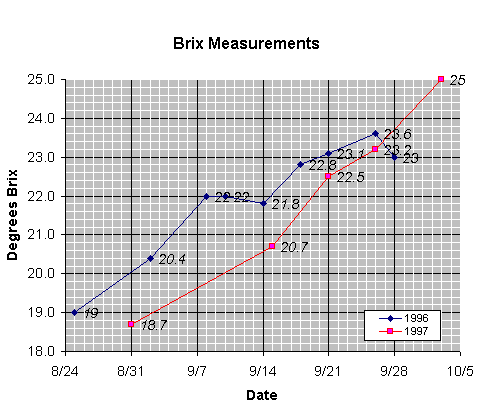Process
Getting Ready for the Year’s Harvest
1997 planning assumption: given both increased production and our being less picky (or more picky, depending on how you view it), our wild guess is four times as much grapes as last year, so we will make sure we can handle five times as much grapes. Since we 7.5 had gallons of must in 1996, we will plan for 37.5 gallons in 1997.Wrong!! …
To do every year:
- Plan harvest party. Need more pruning
shears (and more grape crates?).
Make sure we have fresh chemicals.
Review supply lists for what we need and identify who is responsible.
Reread steps in wine books.
Check batteries in all instruments.
- Take three-day winemaking intensive course
at UC Davis.
- Demptos Cooperage – D
- medium grain, medium toast Naverre 15
gal. and 7.5 gal oak barrels
silicon barrel bungs
Deciding When to Pick (Strategy)
Based on discussions with Brian, we decided that we would follow his practice and pick based solely on sugar content, adjusting acidity later as needed. In contrast, FVtW has both sugar and acidity desired ranges. Deciding based on sugar alone makes deciding when to pick simpler, but is a strong assumption about the well-formedness of the grapes.Brian targets around 24° Brix. Divine targets 23.5° Brix. (In contrast, FVtW targets 22° Brix for all reds. MTWaH had no sugar target we could find.)
The Cabernets that we both like are complex
and rich in fruit, acid, and tannin, that is, a reasonably big wine. To
get such a wine, in 1996 we decided to pick in the range 23.5-24° Brix
(or as close as we could get that let us pick on a weekend). This year
we are targeting at least 24° Brix.
Measuring Sugar in the Grapes (Tactics)
We measure sugar every week or two until the grapes get to roughly 22° Brix and then we measure more often. The last measurement or two we sample more grapes.
|
|
|
|
| 8/25/96 early evening |
|
|
| 9/2/96 early evening |
|
|
| 9/8/96 early evening |
|
|
| 9/10/96 8:30 a.m. |
|
|
| 9/14/96 morning |
|
|
| 9/18/96 8:00 a.m. |
|
|
| 9/21/96 6:00 p.m. |
|
|
| 9/26/96 a.m. |
|
|
| 9/28/96 6:00 p.m.
|
|
|
| 8/31/97 5:00 p.m. |
|
|
| 9/15/97 8:30 a.m. |
|
|
| 9/21/97 6:00 p.m. |
|
|
| 9/26/97 8:30 a.m. |
|
|
| 10/3/97 8:30 a.m. |
|
|
| 10/4
|
The "curve" seems a bit arbitrary. Our
best theory is that sugar increases more with something like degree-hours
than with days, but that this slows down toward the end as the grapes get
bigger. A very hot day increases the sugar much more, especially late in
the maturing. 1996 had some very hot days in the second half of September.
To examine the effect of temperature, we would capture the maximum temperature
for each day. (Does Foothill College’s radio station log this?)
Pick Day
Prep:- Walk through all the steps.
Mark any new primary fermentation containers every two gallons.
Make fresh citric acid and bleach solutions.
Clean well grape picking boxes, crusher, fermentation
containers, and puncher.
- Note: As with many things, the time is in the prep
work, especially the cleaning, not in the picking itself.
- .08 g./gallon x 40 ppm/10 ppm x 37.5 gallons = 12
g.
.32g/gallon
- We were brutal in ’96, throwing away anything
but the most perfect. We will include more bunches in 1997.
Record Brix with both refractometer and hydrometer
(MTWaH, p. 28).
- pH.
Temperature.
TA.
and add to the must.
Make plastic tarp for PFC, cover PFC, and use clip to tighten string to make fairly airtight.
Calculate and record available alcoholTK.
Record all measurements and additions to the wine.
Wait 6 hours to let SO2 settle into the must, killing the bad bacteria.
Punch down must.
Add yeast and yeast food to the must, stir, and re-cover fermenter.
Measure temperature.